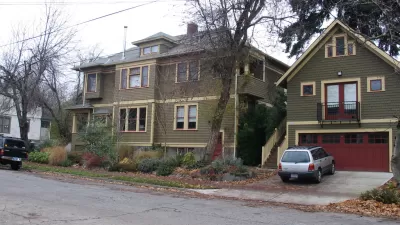Montgomery County, Maryland is confronting a conundrum common to inner-ring suburbs now facing development pressures. How to make the case for protecting mid-century buildings that some consider too young, or "too plain or ugly," to preserve.
Katherine Shaver looks at the efforts of Montgomery County to catalog its mid-century-modern building stock, in the face of redevelopment pressures and the appeal of neo-traditional style developments. The Washington, DC suburb is stepping up its efforts to preserve its recent past by setting up a database - “Montgomery Modern” - of the area's significant buildings and subdivisions from the late 1940s through the early 1960s.
“The challenge is always preserving the recent past,” Clare Lise Kelly, a historic-preservation planner for Montgomery County, said. “It’s easy to look at things from 100 years ago and see them as historic. . . . If we don’t act now to assess resources from this time period, they’ll be gone, and then it’s too late to say, ‘That apartment complex was really special.’ ”
"Kelly said she realizes that some people consider modernist buildings too young — and, in some cases, too plain or ugly — to warrant protection," writes Shaver. "It’s not about age or looks, she said. It’s about preserving critical pieces of architectural history from the post-World War II population and building boom that transformed suburbs such as Montgomery from rural bedroom communities into dense subdivisions and commercial districts."
Thanks to Bora Mici
FULL STORY: Montgomery's 'Mad Men' Modern buildings - are they worth protecting?

Trump Administration Could Effectively End Housing Voucher Program
Federal officials are eyeing major cuts to the Section 8 program that helps millions of low-income households pay rent.

Planetizen Federal Action Tracker
A weekly monitor of how Trump’s orders and actions are impacting planners and planning in America.

Ken Jennings Launches Transit Web Series
The Jeopardy champ wants you to ride public transit.

California Invests Additional $5M in Electric School Buses
The state wants to electrify all of its school bus fleets by 2035.

Austin Launches $2M Homelessness Prevention Fund
A new grant program from the city’s Homeless Strategy Office will fund rental assistance and supportive services.

Alabama School Forestry Initiative Brings Trees to Schoolyards
Trees can improve physical and mental health for students and commnity members.
Urban Design for Planners 1: Software Tools
This six-course series explores essential urban design concepts using open source software and equips planners with the tools they need to participate fully in the urban design process.
Planning for Universal Design
Learn the tools for implementing Universal Design in planning regulations.
Ada County Highway District
Clanton & Associates, Inc.
Jessamine County Fiscal Court
Institute for Housing and Urban Development Studies (IHS)
City of Grandview
Harvard GSD Executive Education
Toledo-Lucas County Plan Commissions
Salt Lake City
NYU Wagner Graduate School of Public Service





























